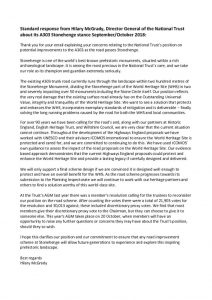Several hundred concerned individuals have written recently to Hilary McGrady, Director-General of the National Trust, about the Trust’s support for the A303 Stonehenge road widening scheme. In response, correspondents have shared the following standard reply from Ms McGrady.
Our suggested response to Ms McGrady’s letter
Dear Ms McGrady,
Thank you for your reply to my letter of concern about the Trust’s position on the A303 Stonehenge tunnel scheme. You say that you hope you have clarified the Trust’s position but numerous statements in your letter indicate that you are either unaware of the Trust’s present position or worse: apparently encouraging misunderstandings in order to justify what can only be considered a matter of seriously poor judgement on the part of the Trust’s Trustees.
Taking these statements in order of appearance in your letter, you say that:
-
“Stonehenge is one of the world’s best known prehistoric monuments . . . It is among the most precious in the National Trust’s care”
The Stonehenge monument is in the care of English Heritage.
-
“We want to see a solution that protects and enhances the WHS”
This is something that the c.3km tunnel supported by the Trust cannot possibly achieve.
-
“For over 90 years we have been calling for the road’s removal”
Please would you let me know where I can find evidence of the Trust’s efforts over this time to remove the A303? Are you aware that the A303 in its present form dates to the late 1960s and that the Trust released land for its dualling and realignment, rather than for its removal?
You may also be aware that, at the time of designation of the World Heritage Site, the A303 was not mentioned as being a problem. Indeed, I would be interested to know what suggestions the Trust had 90 years ago for replacing the A303 at Stonehenge, should it be ‘removed’.
-
“Throughout the development of the Highways England proposals we have worked with UNESCO and their advisors ICOMOS International to ensure the World Heritage Site is protected and cared for, and we are committed to continuing to do this.”
The reports about the A303 scheme by the joint UNESCO World Heritage Centre and ICOMOS advisory missions advise that they would like Highways England to “ensure the World Heritage Site is protected and cared for”. Clearly this is obviously not the current intention of Highways England or those bodies, including the Trust, who support the road scheme. So it does not appear correct for you to say that the Trust has worked with UNESCO and ICOMOS advisors to “ensure the World Heritage Site is protected and cared for”; nor would it appear that the Trust itself is committed to ensuring that end.
-
“Our evidence based approach demonstrates that the current Highways England proposals could protect and enhance the World Heritage Site and provide a lasting legacy if carefully designed and delivered.”
The Trust’s ”evidence based approach” is evidently seriously flawed if the Trust thinks that Highways England’s proposals could ever “protect and enhance the World Heritage Site”. The tunnel is far too short to achieve that aim.
-
“We will only support a final scheme design if we are convinced it is designed well enough to protect and have an overall benefit for the WHS. As the road scheme progresses towards its submission to the Planning Inspectorate we will continue to work with our heritage partners and others to find a solution worthy of this world-class site.”
Why then does the Trust support a c.3km tunnel which will not “protect and have an overall benefit for the WHS”? There is little time left for the Trust to work with ‘heritage partners’ and ‘others’ to ”find a solution worthy of this world class site” before the Development Consent Order application is made to the Planning Inspectorate.
-
“At the Trust’s AGM last year there was a member’s resolution calling for the trustees to reconsider our position on the road scheme. After counting the votes there were a total of 21,903 votes for the resolution and 30,013 against; these included discretionary proxy votes. We find that most members give their discretionary proxy vote to the Chairman, but they can choose to give it to someone else.”
This explanation fails to reveal that the resolution was to uphold its founding principles and that voting on the members’ motion on Stonehenge, according to the Trust’s own record, was as follows:
| For | Against | |
| Specified | 21,898 | 23,303 |
| Discretionary | 5 | 6,710 |
| TOTAL | 21,903 | 30,013 |
Thus, the specified vote was fairly close and the motion was lost because the chairman cast the 6,710 discretionary votes against rather than for the motion.
-
“I hope this clarifies our position”
I am sorry that your letter has not clarified the Trust’s position. I would be grateful if you should absolutely clarify the Trust’s position in the light of my responses to the various statements in your letter.
It would, of course, be widely welcomed if the Trust’s stance were to be changed to one of commitment to protecting the entire World Heritage Site and its setting. If that were to occur, and I sincerely hope it will, then the Trust could obviously not be a supporter of the c.3km tunnel scheme.
Yours, etc.
Please share


